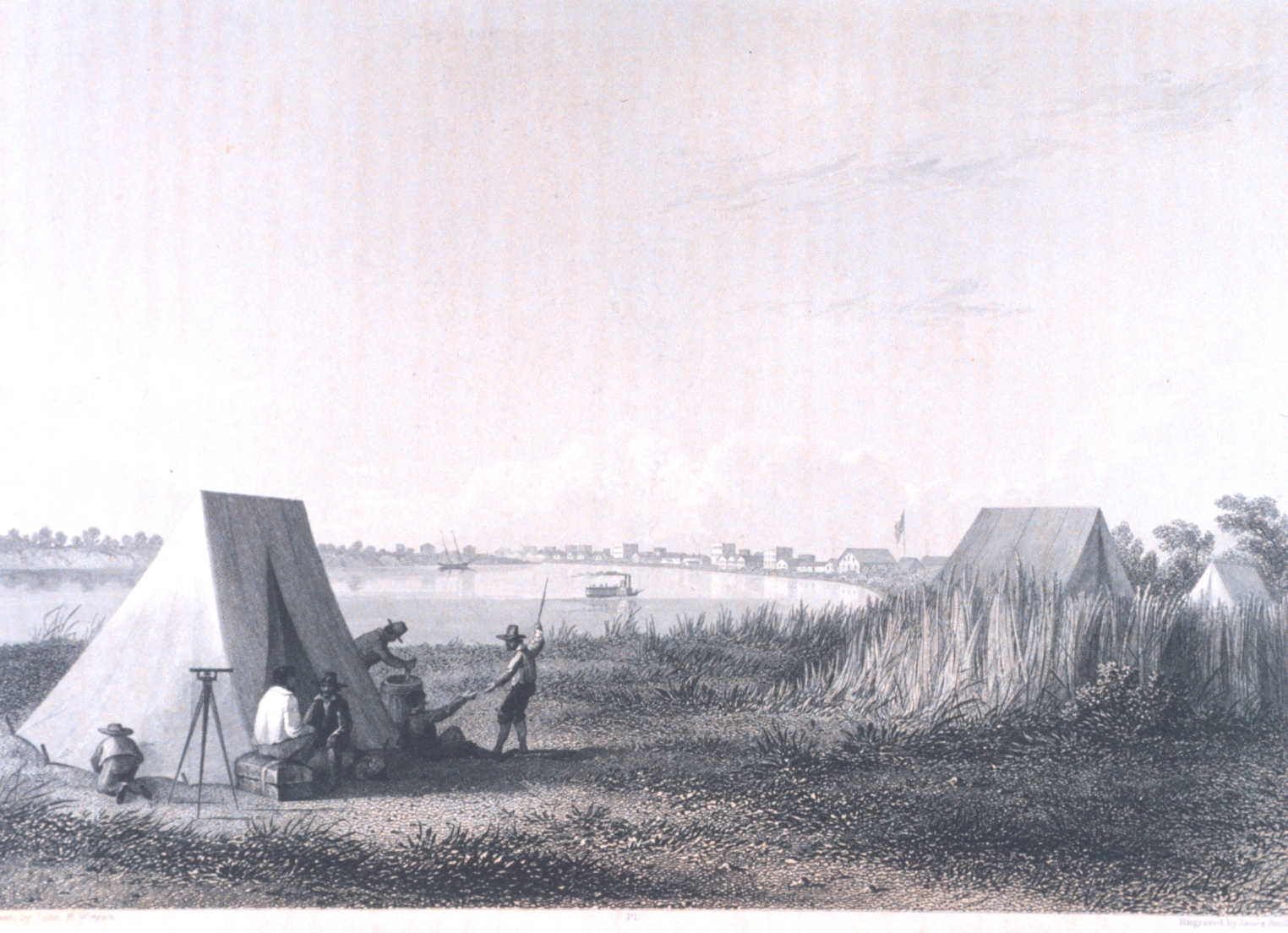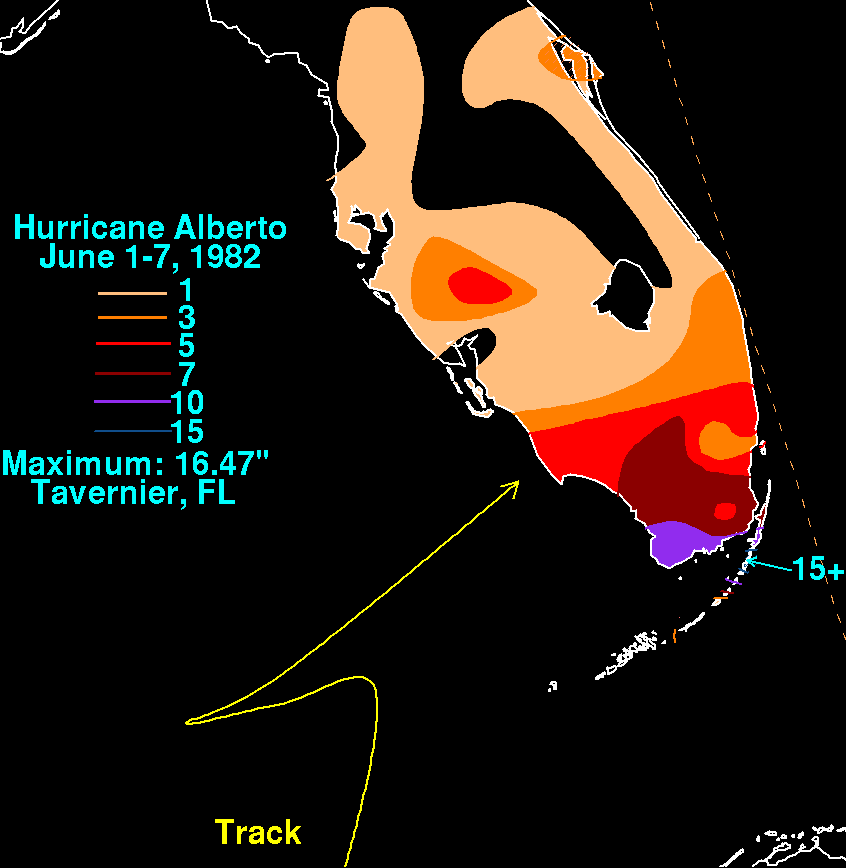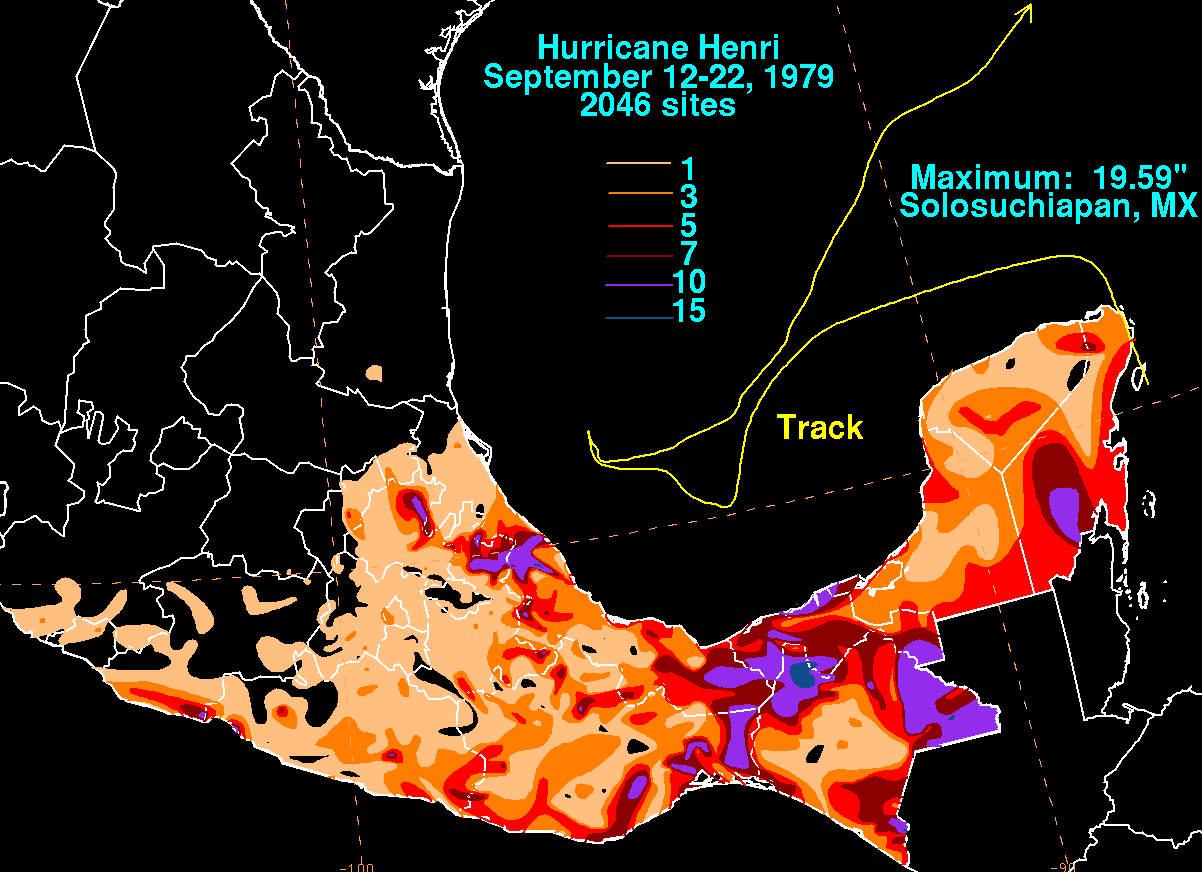|
Hurricane Jeanne (1980)
Hurricane Jeanne was a moderate hurricane that formed and dissipated in the Gulf of Mexico without making landfall, only one of four occurrences in the 20th century. The thirteenth tropical cyclone, tenth named storm, and eighth hurricane of the 1980 Atlantic hurricane season, Jeanne developed over the southern Caribbean on November 7. It moved swiftly northward, and it intensified to a tropical storm on November 9. It entered the southern Gulf of Mexico on November 10. Jeanne turned to the west on November 11, and it rapidly intensified to its peak intensity of . It weakened on November 12, and its forward motion slowed; the cyclone weakened further to a tropical storm because of dry air intrusion, and it executed a clockwise loop on November 15. It dissipated on November 16. At the time, Jeanne was one of three November hurricanes in the Gulf of Mexico; it was the first tropical cyclone to attain hurricane strength in the Gulf of Mexico during November. The late season storm s ... [...More Info...] [...Related Items...] OR: [Wikipedia] [Google] [Baidu] |
Gulf Of Mexico
The Gulf of Mexico ( es, Golfo de México) is an oceanic basin, ocean basin and a marginal sea of the Atlantic Ocean, largely surrounded by the North American continent. It is bounded on the northeast, north and northwest by the Gulf Coast of the United States; on the southwest and south by the Mexico, Mexican States of Mexico, states of Tamaulipas, Veracruz, Tabasco, Campeche, Yucatan, and Quintana Roo; and on the southeast by Cuba. The Southern United States, Southern U.S. states of Texas, Louisiana, Mississippi, Alabama, and Florida, which border the Gulf on the north, are often referred to as the "Third Coast" of the United States (in addition to its Atlantic and Pacific Ocean, Pacific coasts). The Gulf of Mexico took shape approximately 300 million years ago as a result of plate tectonics.Huerta, A.D., and D.L. Harry (2012) ''Wilson cycles, tectonic inheritance, and rifting of the North American Gulf of Mexico continental margin.'' Geosphere. 8(1):GES00725.1, first p ... [...More Info...] [...Related Items...] OR: [Wikipedia] [Google] [Baidu] |
Brownsville, Texas
Brownsville () is a city in Cameron County in the U.S. state of Texas. It is on the western Gulf Coast in South Texas, adjacent to the border with Matamoros, Mexico. The city covers , and has a population of 186,738 as of the 2020 census. It is the 139th-largest city in the United States and 18th-largest in Texas. It is part of the Matamoros–Brownsville metropolitan area. The city is known for its year-round subtropical climate, deep-water seaport, and Hispanic culture. The city was founded in 1848 by American entrepreneur Charles Stillman after he developed a successful river-boat company nearby. It was named for Fort Brown, itself named after Major Jacob Brown, who fought and died while serving as a U.S. Army soldier during the Mexican–American War (1846–1848). As a county seat, the city and county governments are major employers. Other primary employers fall within the service, trade, and manufacturing industries, including a growing aerospace and space transpor ... [...More Info...] [...Related Items...] OR: [Wikipedia] [Google] [Baidu] |
List Of Texas Hurricanes ...
The state of Texas has had many hurricanes affect it. It is the US state with the second-most hurricanes affecting it, only behind Florida. Storms affecting it go back to 1527. Pre-1900 1900–1949 1950–1979 1980–present See also * List of United States hurricanes References {{reflist * Texas Hurricanes A tropical cyclone is a rapidly rotating storm system characterized by a low-pressure center, a closed low-level atmospheric circulation, strong winds, and a spiral arrangement of thunderstorms that produce heavy rain and squalls. Depend ... [...More Info...] [...Related Items...] OR: [Wikipedia] [Google] [Baidu] |
Hurricane Alberto (1982)
Hurricane Alberto was a Category 1 hurricane that caused the worst flooding in western Cuba in 32 years. The first tropical storm and hurricane of the 1982 Atlantic hurricane season, Alberto developed from a tropical disturbance on June 2 in the southern Gulf of Mexico. It rapidly organized and attained hurricane status the following day, the earliest date for a hurricane in the Atlantic Ocean since Hurricane Alma in May 1970. Shortly after reaching peak winds off , Alberto rapidly weakened due to approaching upper-level winds. Initial forecasts predicted the hurricane would continue northeastward into Florida; it turned sharply westward and drifted erratically for several days across the eastern Gulf of Mexico, before dissipating on June 6. Alberto produced heavy rainfall in western Cuba, causing flash flooding and severe damage. The storm damaged 8,745 houses and destroyed 154 buildings, leaving hundreds homeless. Heavy rainfall continued in the country for severa ... [...More Info...] [...Related Items...] OR: [Wikipedia] [Google] [Baidu] |
Hurricane Henri (1979)
Hurricane Henri was a rare tropical cyclone that entered the Gulf of Mexico without having made landfall; it was the second of four times this occurred during the 20th century. The eighth named storm and fifth hurricane of the 1979 Atlantic hurricane season, it formed on September 14 in the northwestern Caribbean Sea. Throughout much of its duration, Henri moved erratically and initially maintained a general westward track. On September 16 it attained tropical storm status, and a day later it reached hurricane status. By two days later, after experiencing hostile conditions, Henri weakened to tropical depression status as it turned to the northeast, before degenerating into a remnant low on September 21. On September 24, it merged with a frontal low in the northeast Gulf of Mexico. Due to its slow and erratic motion, the hurricane forced evacuations along the Mexican coastline. Its remnants brought rainfall and flooding to the Florida Panhandle. Meteorological history Hurricane H ... [...More Info...] [...Related Items...] OR: [Wikipedia] [Google] [Baidu] |
1969 Atlantic Hurricane Season
The 1969 Atlantic hurricane season was the most active Atlantic hurricane season since the 1933 season, and was the final year of the most recent positive ("high-quality") Atlantic multidecadal oscillation (AMO) era. The hurricane season officially began on June 1, and lasted until November 30. The season had the highest number of systems reach hurricane status – twelve – in a single season, until that record was surpassed in 2005. The season was above-average despite an El Niño, which typically suppresses activity in the Atlantic Ocean, while increasing tropical cyclone activity in the Pacific Ocean. Activity began with a tropical depression that caused extensive flooding in Cuba and Jamaica in early June. On July 25, Tropical Storm Anna developed, the first named storm of the season. Later in the season, Tropical Depression Twenty-Nine caused severe local flooding in the Florida Panhandle and southwestern Georgia in September. The most significant storm of ... [...More Info...] [...Related Items...] OR: [Wikipedia] [Google] [Baidu] |
Landfall (meteorology)
Landfall is the event of a storm moving over land after being over water. More broadly, and in relation to human travel, it refers to 'the first land that is reached or seen at the end of a journey across the sea or through the air, or the fact of arriving there. Tropical cyclone A tropical cyclone is classified as making landfall when the center of the storm moves across the coast; in a relatively strong tropical cyclone, this is when the eye moves over land. This is where most of the damage occurs within a mature tropical cyclone, such as a typhoon or hurricane, as most of the damaging aspects of these systems are concentrated near the eyewall. Such effects include the peaking of the storm surge, the core of strong winds coming ashore, and heavy flooding rains. These coupled with high surf can cause major beach erosion. When a tropical cyclone makes landfall, the eye usually closes in upon itself due to negative environmental factors over land, such as friction with th ... [...More Info...] [...Related Items...] OR: [Wikipedia] [Google] [Baidu] |
Galveston, Texas
Galveston ( ) is a coastal resort city and port off the Southeast Texas coast on Galveston Island and Pelican Island in the U.S. state of Texas. The community of , with a population of 47,743 in 2010, is the county seat of surrounding Galveston County and second-largest municipality in the county. It is also within the Houston–The Woodlands–Sugar Land metropolitan area at its southern end on the northwestern coast of the Gulf of Mexico. Galveston, or Galvez' town, was named after 18th-century Spanish military and political leader Bernardo de Gálvez y Madrid, Count of Gálvez (1746–1786), who was born in Macharaviaya, Málaga, in the Kingdom of Spain. Galveston's first European settlements on the Galveston Island were built around 1816 by French pirate Louis-Michel Aury to help the fledgling empire of Mexico fight for independence from Spain, along with other colonies in the Western Hemisphere of the Americas in Central and South America in the 1810s and 1820s. The Po ... [...More Info...] [...Related Items...] OR: [Wikipedia] [Google] [Baidu] |
Key West International Airport
Key West International Airport is an international airport located in the City of Key West in Monroe County, Florida, United States, east of the main commercial center of Key West. Flights departing from EYW often have weight restrictions, because the airport's runway is only long. History Key West's aviation history began in 1913 with a flight to Cuba by Augustin Parla. In 1928, Pan American Airways began scheduled flights from Key West. The main runway at Meacham Field was pressed into U.S. Army use after the Pearl Harbor attack, as well as into U.S. Navy use later in World War II as an alternative to the Trumbo Point seaplane base and the main Naval Air Station for fixed-wing and lighter-than-air (blimp) aircraft on Boca Chica Key. After the war, the city took over what became Key West Municipal Airport. In January 1953, the city gave Monroe County the title to Meacham Field, allowing the county to apply for Federal Aviation Administration grants. Around the same t ... [...More Info...] [...Related Items...] OR: [Wikipedia] [Google] [Baidu] |
Mesoscale Meteorology
Mesoscale meteorology is the study of weather systems smaller than synoptic scale systems but larger than Microscale meteorology, microscale and storm-scale cumulus systems. Horizontal dimensions generally range from around 5 kilometers to several hundred kilometers. Examples of mesoscale weather systems are sea breezes, squall lines, and mesoscale convective complexes. Vertical velocity often equals or exceeds horizontal velocities in mesoscale meteorological systems due to nonhydrostatic processes such as buoyant acceleration of a rising thermal or acceleration through a narrow mountain pass. Subclasses Mesoscale Meteorology is divided into these subclasses: * Meso-alpha 200–2000 km scale of phenomena like fronts, squall lines, mesoscale convective systems (MCS), tropical cyclones at the edge of synoptic scale * Meso-beta 20–200 km scale of phenomena like sea breezes, lake effect snow storms * Meso-gamma 2–20 km scale of phenomena like thunderstorm convectio ... [...More Info...] [...Related Items...] OR: [Wikipedia] [Google] [Baidu] |
Jeanne 1980 Rainfall
Jeanne may refer to: Places * Jeanne (crater), on Venus People * Jeanne (given name) * Joan of Arc (Jeanne d'Arc, 1412–1431) * Joanna of Flanders (1295–1374) * Joan, Duchess of Brittany (1319–1384) * Ruth Stuber Jeanne (1910–2004), American marimbist, percussionist, violinist, and arranger * Jeanne de Navarre (other), multiple people * Leon Jeanne (born 1980), Welsh footballer Fictional characters *Jeanne, a character from the ''Bayonetta'' series of video games Arts and entertainment * ''Jeanne'' (1934 film), a French drama film * ''Jeanne'', also known as ''Joan of Arc'', a 2019 French drama film * ''Jeanne'', an 1844 novel by George Sand Other uses * Tropical Storm Jeanne (other) See also * Joan (other) * Joanna * Joanne (other) * Jean (other) * Jehanne (other) * Gene (other) A gene is a sequence of DNA or RNA that codes for a molecule that has a function. Gene or Genes also may refer to: Given nam ... [...More Info...] [...Related Items...] OR: [Wikipedia] [Google] [Baidu] |
Lafourche Parish, Louisiana
Lafourche Parish (french: Paroisse de la Fourche) is a parish located in the south of the U.S. state of Louisiana. The parish seat is Thibodaux. The parish was formed in 1807. It was originally the northern part of Lafourche Interior Parish, which consisted of the present parishes of Lafourche and Terrebonne. Lafourche Parish was named after the Bayou Lafourche. City buildings have been featured in television and movies, such as in ''Fletch Lives'', due to its architecture and rich history. At the 2020 census, its population was 97,557. Long a center of sugar cane plantations and sugar production, in November 1887 the parish was the site of the Thibodaux Massacre. After state militia were used to suppress a massive Knights of Labor strike involving 10,000 workers in four parishes, many African Americans retreated to Thibodaux. Local paramilitary forces attacked the men and their families, killing an estimated 50 persons. Hundreds more were missing, wounded, and presumed dead in ... [...More Info...] [...Related Items...] OR: [Wikipedia] [Google] [Baidu] |







